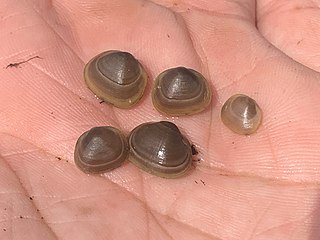
Narthecium asiaticum is a species of plants traditionally placed in the Liliaceae, but now considered a member of the Nartheciaceae. It is endemic to Japan.
Mycobacterium asiaticum is a slowly growing photochromogenic mycobacterium first isolated from monkeys in 1965. M. asiaticum can, but rarely, causes human pulmonary disease.

Sphaerium corneum, also known as the European fingernailclam, is a very small freshwater clam, an aquatic bivalve mollusk in the family Sphaeriidae, the fingernail clams.

Sphaerium is a genus of very small freshwater clams, aquatic bivalve molluscs in the family Sphaeriidae, known as the fingernail clams. The small clams in this genus are unusual in that many of them, such as Sphaerium corneum, can climb around underwater on aquatic plants, using their long and strong foot.
Sphaerium nucleus is a freshwater bivalve of the family Sphaeriidae. It has been often confused with Sphaerium corneum and is consequently quite poorly known.

Sphaeriidae is a family of small to minute freshwater bivalve molluscs in the order Sphaeriida. In the US, they are commonly known as pea clams or fingernail clams.
Sphaerium solidum, the solid orb mussel, is a species of freshwater bivalve from family Sphaeriidae.

Crinum asiaticum, commonly known as poison bulb, giant crinum lily, grand crinum lily, or spider lily, is a plant species widely planted in many warmer regions as an ornamental. It is a bulb-forming perennial producing an umbel of large, showy flowers that are prized by gardeners. However, all parts of the plant are poisonous if ingested. Some reports indicate exposure to the sap may cause skin irritation.

Liodon is a dubious genus of mosasaur from the Late Cretaceous, known from fragmentary fossils discovered in St James' Pit, England and possibly also the Ouled Abdoun Basin of Morocco. Though dubious and of uncertain phylogenetic affinities, Liodon was historically a highly important taxon in mosasaur systematics, being one of the genera on which the family Mosasauridae was based.

Calycoceras is an extinct genus of cephalopods belonging to the subclass Ammonoidea and family Acanthoceratidae that lived during the Cenomanian stage of the Late Cretaceous, 100-94 Mya. Their shells had ornate ribs.

Trachelospermum asiaticum, the Asiatic jasmine, is a species of flowering plant in the family Apocynaceae and it is native to Asia. Its flowers resemble stars, so it is also referred to as yellow star jasmine or Asian star jasmine. This is a fast growing evergreen vine, often used to cover fences, walls, and similar surfaces. It is heat- and cold- tolerant, and grows even in shady areas.
Sphaerium beckmani is an extinct species of fossil freshwater pea clams from the Late Cretaceous deposits of North America. This species was first described by the American paleontologist Loris Shano Russell in 1976. The specimens were collected by the American paleontologist Karl M. Waage from 1961 to 1962 from the Hell Creek Formation of eastern Montana. The locality is dated to the late Maastrichtian Age.

Sphaerium rhomboideum, the rhomboid fingernailclam, is a species of freshwater clams in the family Sphaeriidae. It is found in North America.
Marihabitans asiaticum is a species of Gram positive, nonmotile, non-sporeforming bacteria. The bacteria are aerobic and mesophilic, and the cells are irregular rods or coccoid. The species was first described in 2008, and it was originally isolated in 2003 from surface seawater collected at the Kesennuma ferry port in Miyagi Prefecture, Japan. The species name refers to the region (Asia) from which it was first isolated. M. asiaticum is the type species of genus Marihabitans, and is currently the only species in the genus.

Sceliphron asiaticum is a species of thread-waisted wasp in the family Sphecidae. It is native to the Neotropics, South America and the Caribbean region.









